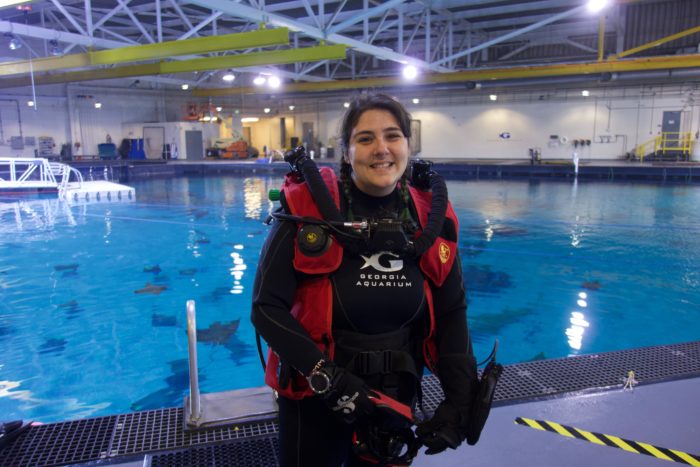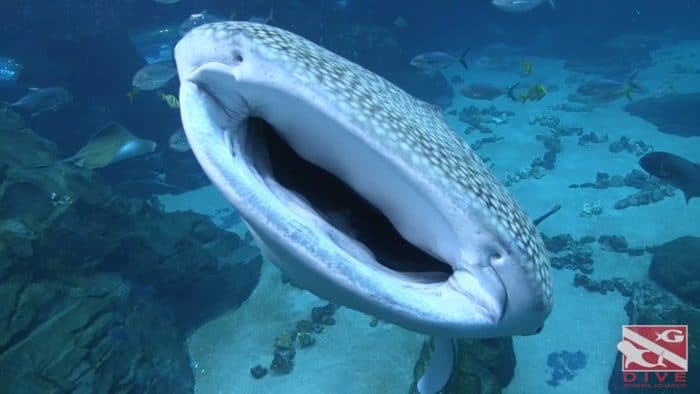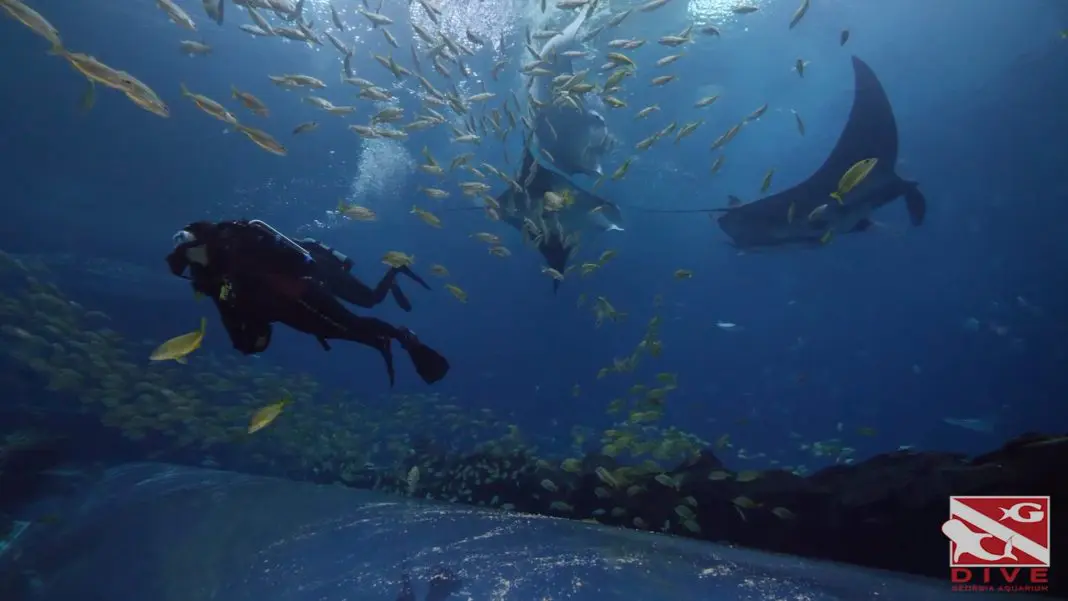The strangest place I’ve ever done a dive is 267 miles from the nearest beach in Atlanta, home of the Georgia Aquarium. Getting to dive in an aquarium has been on my wishlist since before I was a diver, and this remarkable enclosure is home to some of the most intriguing marine megafauna in the world. Thanks to fellow #teamDB staffer Sarah Barrett and the team at the aquarium I’m pleased to say I’ve ticked this off my wishlist!
What that means for guests is a chance to view a variety of fish, rays, sharks, and even a massive green turtle named Tank. Some of the strange denizens include sandbar, blacktip reef, and zebra sharks as well as giant and bowmouth guitarfish. For sheer weirdness, the spotted and tasseled wobbegongs are second only to the sawtooth ray. There are groupers, giant trevally, angelfish, porkfish, sergeant majors, and one very curious humphead wrasse (affectionately known as Scooter). The real stars though are the graceful mantas giant whale sharks. Of the four mantas, three are of the smaller – but still, massive – reef species, but the fourth, playful and curious Talulah, is a pelagic manta with a wingspan of fifteen feet.
The tank is also a research facility. Rescued from an untimely end in the fish trade in Taiwan, the whale sharks are hand-fed and closely monitored. Health data, including blood hormone levels, are compared with data gathered from wild specimens to study how life in captivity affects the stress and well-being of the sharks in comparison. By this accounting, Alice, Trixie, Taroko, and Yushan seem to be thriving.
We also featured the Volunteer Diver Program supporting the aquarium that you can see below or on YouTube.
Built by Home Depot, the Ocean Voyager exhibit opened in 2005 and still holds the distinction of being the largest tank in the world–6.3 million gallons (24.8 million liters)! It ranges from twenty feet (6 m) in the shallow end to thirty feet (9 m) in front of the gigantic acrylic viewing window, and is about as big around as a football field. The temperature is 77°F (25°C), which makes the exhibit a comfortable home for marine animals from similar zones in the Pacific, Atlantic, and Indian oceans–and occasionally strange animals from the land.
To many intrepid divers, the words “indoor try dive” might inspire a passionate yawn, but the closed-circuit rebreather immersion experience in the Ocean Voyager tank is the dive of a lifetime. Definite bucket list material. Those of us who’ve only dove open-circuit regulators have heard the lore – when you stop making bubbles, marine life of all sorts will get closer and stay longer. With the help of some of the biggest, smartest fish in the world, the friendly and expert staff will show you first-hand.
The Georgia Aquarium opened their Dive Immersion program in 2008, and the most common feedback they received on the program was a wish for the one thing every diver craves – more bottom time! In March of 2016, they responded with the debut of the closed-circuit rebreather program. This experience is analogous to a SCUBA try dive – there’s a classroom and gear orientation, a series of skills divers must perform correctly, followed by an underwater adventure. On this try dive, though, you might look up from your partial mask flood to find the belly of a whale shark blocking out the light from above.
Rebreathers have always seemed a bit daunting to me, but this program offers a soft introduction in a controlled environment. All staff who lead guests must have instructor level dive certifications, and they keep a ratio of three divemasters for every four guests (eight for the open-circuit dive).

The rebreather unit is a Poseidon Se7en, compact and practically idiot-proof. Before you can dive, the digital information paddle leads you through a series of 55 different tests to make sure everything is online and ready to go. And after that, you still have to do a five-minute pre-breath session before you can hit the water. An LED heads-up display will flash at the bottom of your field of vision to remind you to check your computer or alert you to any equipment issues as you dive.
Regarding the closed-circuit experience, let me tell you–the hype is true. As I waited my turn to perform the skills at the beginning of the dive, a bright yellow french grunt drifted casually by, inches from my mask. We checked each other out at an extreme close-up range, and it even came back for a second pass. The most unforgettable encounter happened as one of the mantas was doing backward summersaults near the surface. As it neared the bottom and came right-side up, it passed close enough for eye contact. That kind of mutual awareness without fear is one of the most special things about spending time underwater.
Scuba is a great way to experience the environment, but with the rebreather, I felt like it was much more interested in experiencing me back. If that sounds like your kind of adventure, get yourself the Georgia Aquarium and let it experience you, too!

There are a number of options for diving at the Georgia Aquarium, including Swimming, Open Circuit Scuba, Closed Circuit Rebreather (CCR) as I did or if you’re not a diver (or you’d rather not get wet), check out some of the other animals encounters offered at the aquarium. If you don’t mind getting wet, but prefer mammals, try the beluga whale interaction.

